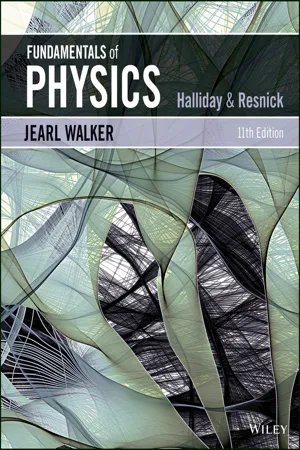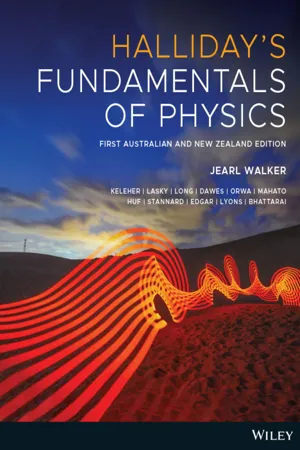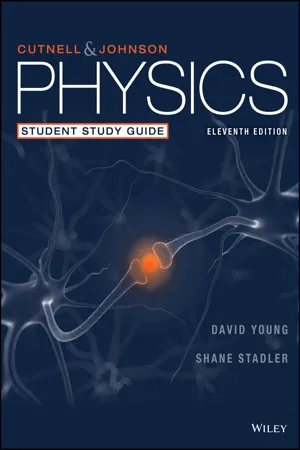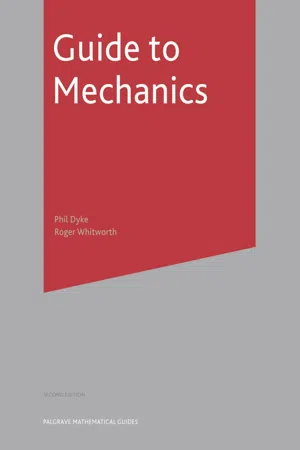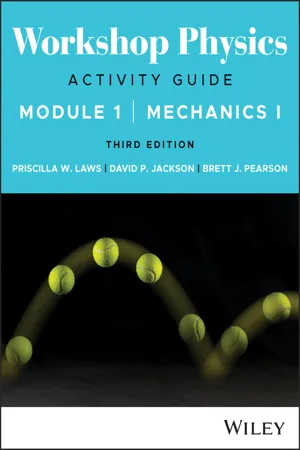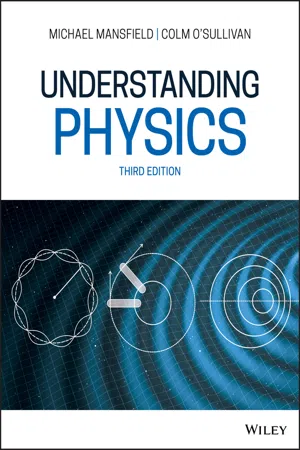Physics
Force and Motion
Force and motion are fundamental concepts in physics that describe the interaction between objects and their resulting movement. Force is a push or pull acting on an object, causing it to accelerate, decelerate, or change direction. Motion refers to the change in position of an object over time, influenced by the application of force.
Written by Perlego with AI-assistance
12 Key excerpts on "Force and Motion"
- eBook - PDF
- David Halliday, Robert Resnick, Jearl Walker(Authors)
- 2020(Publication Date)
- Wiley(Publisher)
79 What Is Physics? We have seen that part of physics is a study of motion, including accelerations, which are changes in velocities. Physics is also a study of what can cause an object to accelerate. That cause is a force, which is, loosely speaking, a push or pull on the object. The force is said to act on the object to change its velocity. For example, when a dragster accelerates, a force from the track acts on the rear tires to cause the dragster’s acceleration. When a defensive guard knocks down a quarterback, a force from the guard acts on the quarterback to cause the quarterback’s backward acceleration. When a car slams into a telephone pole, a force on the car from the C H A P T E R 5 Force and Motion—I 5-1 NEWTON’S FIRST AND SECOND LAWS After reading this module, you should be able to . . . 5.01 Identify that a force is a vector quantity and thus has both magnitude and direction and also components. 5.02 Given two or more forces acting on the same par- ticle, add the forces as vectors to get the net force. 5.03 Identify Newton’s first and second laws of motion. 5.04 Identify inertial reference frames. 5.05 Sketch a free-body diagram for an object, show- ing the object as a particle and drawing the forces acting on it as vectors with their tails anchored on the particle. 5.06 Apply the relationship (Newton’s second law) between the net force on an object, the mass of the object, and the acceleration produced by the net force. 5.07 Identify that only external forces on an object can cause the object to accelerate. ● The velocity of an object can change (the object can accelerate) when the object is acted on by one or more forces (pushes or pulls) from other objects. Newtonian mechanics relates accelerations and forces. ● Forces are vector quantities. Their magnitudes are defined in terms of the acceleration they would give the standard kilogram. A force that accelerates that standard body by exactly 1 m/s 2 is defined to have a magnitude of 1 N. - eBook - PDF
- David Halliday, Robert Resnick, Jearl Walker(Authors)
- 2018(Publication Date)
- Wiley(Publisher)
94 What Is Physics? We have seen that part of physics is a study of motion, including accelerations, which are changes in velocities. Physics is also a study of what can cause an object to accelerate. That cause is a force, which is, loosely speaking, a push or pull on the object. The force is said to act on the object to change its velocity. For example, when a dragster accelerates, a force from the track acts on the rear tires to cause the dragster’s acceleration. When a defensive guard knocks down a quarterback, a force from the guard acts on the quarterback to cause the quarterback’s backward acceleration. When a car slams into a telephone pole, a force on the car from the C H A P T E R 5 Force and Motion—I 5-1 NEWTON’S FIRST AND SECOND LAWS After reading this module, you should be able to . . . 5.01 Identify that a force is a vector quantity and thus has both magnitude and direction and also components. 5.02 Given two or more forces acting on the same par- ticle, add the forces as vectors to get the net force. 5.03 Identify Newton’s first and second laws of motion. 5.04 Identify inertial reference frames. 5.05 Sketch a free-body diagram for an object, show- ing the object as a particle and drawing the forces acting on it as vectors with their tails anchored on the particle. 5.06 Apply the relationship (Newton’s second law) between the net force on an object, the mass of the object, and the acceleration produced by the net force. 5.07 Identify that only external forces on an object can cause the object to accelerate. ● The velocity of an object can change (the object can accelerate) when the object is acted on by one or more forces (pushes or pulls) from other objects. Newtonian mechanics relates accelerations and forces. ● Forces are vector quantities. Their magnitudes are defined in terms of the acceleration they would give the standard kilogram. A force that accelerates that standard body by exactly 1 m/s 2 is defined to have a magnitude of 1 N. - David Halliday, Jearl Walker, Patrick Keleher, Paul Lasky, John Long, Judith Dawes, Julius Orwa, Ajay Mahato, Peter Huf, Warren Stannard, Amanda Edgar, Liam Lyons, Dipesh Bhattarai(Authors)
- 2020(Publication Date)
- Wiley(Publisher)
CHAPTER 5 Force and Motion — I 5.1 Newton’s frst and second laws LEARNING OBJECTIVES After reading this module, you should be able to: 5.1.1 identify that a force is a vector quantity and thus has both magnitude and direction and also components 5.1.2 given two or more forces acting on the same particle, add the forces as vectors to get the net force 5.1.3 identify Newton’s frst and second laws of motion 5.1.4 identify inertial reference frames 5.1.5 sketch a free‐body diagram for an object, showing the object as a particle and drawing the forces acting on it as vectors with their tails anchored on the particle 5.1.6 apply the relationship (Newton’s second law) between the net force on an object, the mass of the object, and the acceleration produced by the net force 5.1.7 identify that only external forces on an object can cause the object to accelerate. KEY IDEAS • The velocity of an object can change (the object can accelerate) when the object is acted on by one or more forces (pushes or pulls) from other objects. Newtonian mechanics relates accelerations and forces. • Forces are vector quantities. Their magnitudes are defned in terms of the acceleration they would give the standard kilogram. A force that accelerates that standard body by exactly 1 m/s 2 is defned to have a magnitude of 1 N. The direction of a force is the direction of the acceleration it causes. Forces are combined according to the rules of vector algebra. The net force on a body is the vector sum of all the forces acting on the body. • If there is no net force on a body, the body remains at rest if it is initially at rest or moves in a straight line at constant speed if it is in motion. • Reference frames in which Newtonian mechanics holds are called inertial reference frames or inertial frames. Reference frames in which Newtonian mechanics does not hold are called noninertial reference frames or noninertial frames.- eBook - PDF
- John D. Cutnell, Kenneth W. Johnson, David Young, Shane Stadler(Authors)
- 2018(Publication Date)
- Wiley(Publisher)
CHAPTER4 Forces and Newton's Laws of Motion PREVIEW In this chapter you will begin the study of dynamics, that branch of physics which explains why objects accelerate. You will be introduced to the concept of force, and study Newton's laws of motion, which apply to all forces that occur in nature. You will learn how to construct free-body diagrams, and use them to analyze systems subject to such forces as gravity and friction. You will also apply Newton's laws of motion to solve a number of different problems. The applications will include both equilibrium and non-equilibrium problems. QUICK REFERENCE Important Terms Force The push or pull required to change the state of motion of an object, as defined by Newton's second law. It is a vector quantity with units of newtons (N), dynes (dyn), or pounds (lb ). Inertia The natural tendency of an object to remain at rest or in uniform motion at a constant speed in a straight line. Mass A quantitative measure of inertia. Units are kilograms (kg), grams (g), or slugs (sl). Inertial Reference Frame A reference frame in which Newton's law of inertia is valid. Free-Body Diagram A vector diagram that represents all of the forces acting on an object. Gravitational Force The force of attraction that every particle of mass in the universe exerts on every other particle. Weight The gravitational force exerted by the earth (or some other large astronomical body) on an object. Normal Force One component of the force that a surface exerts on an object with which it is in contact. This component is directed normal, or perpendicular, to the surface. Friction The force that an object encounters when it moves or attempts to move along a surface. It is always directed parallel to the surface in question. Tension The tendency of a rope (or similar object) to be pulled apart due to the forces that are applied at either end. Equilibrium The state an object is in if it has zero acceleration. - eBook - PDF
- James Shipman, Jerry Wilson, Charles Higgins, Bo Lou, James Shipman(Authors)
- 2020(Publication Date)
- Cengage Learning EMEA(Publisher)
(See ● Fig. 3.1.) 3.1 Force and Net Force Key Questions ● Does a force always produce motion? ● What is the condition for motion when more than one force acts? First let’s look at the meaning of force. It is easy to give examples of forces, but how would you define a force? A force is defined in terms of what it does, and as you know from experience, a force can produce changes in motion. A force can set a stationary object into motion. It can also speed up or slow down a moving object, or it can change the direction of the motion. In other words, a force can produce a change in velocity (speed and/or direction) or an acceleration. Therefore, an observed change in motion, including motion starting from rest, is evidence of a force, which leads to the following definition: A force is a vector quantity capable of producing motion or a change in motion, that is, a change in velocity or an acceleration (Chapter 2.3). The word capable here is significant. A force may act on an object, but its capabil- ity to produce a change in motion may be balanced or canceled by one or more other forces. The net effect is then zero. Thus, a force does not necessarily produce a change in motion. It follows, though, that if a force acts alone, then the object on which it acts will exhibit a change in velocity, or an acceleration. To take into account the application of more than one force on an object, we speak of an unbalanced or net force. To understand the difference between balanced and unbalanced forces, consider the tug of war shown in ● Fig. 3.2a. Forces are applied, Figure 3.1 The Man and the Book (a) Sir Isaac Newton (1642–1727). - eBook - PDF
- John D. Cutnell, Kenneth W. Johnson, David Young, Shane Stadler(Authors)
- 2015(Publication Date)
- Wiley(Publisher)
4.1 | The Concepts of Force and Mass In common usage, a force is a push or a pull, as the examples in Figure 4.1 illustrate. In football, an offensive lineman pushes against his opponent. The tow bar attached to a speed- ing boat pulls a water skier. Forces such as those that push against the football player or pull the skier are called contact forces, because they arise from the physical contact between two objects. There are circumstances, however, in which two objects exert forces on one another even though they are not touching. Such forces are referred to as noncontact forces or action-at-a-distance forces. One example of such a noncontact force occurs when a diver is pulled toward the earth because of the force of gravity. The earth exerts this force even when it is not in direct contact with the diver. In Figure 4.1, arrows are used to rep- resent the forces. It is appropriate to use arrows, because a force is a vector quantity and has both a magnitude and a direction. The direction of the arrow gives the direction of the force, and the length is proportional to its strength or magnitude. The word mass is just as familiar as the word force. A massive supertanker, for instance, is one that contains an enormous amount of mass. As we will see in the next section, it is difficult to set such a massive object into motion and difficult to bring it to a halt once it is moving. In comparison, a penny does not contain much mass. The emphasis here is on the amount of mass, and the idea of direction is of no concern. Therefore, mass is a scalar quantity. During the seventeenth century, Isaac Newton, building on the work of Galileo, developed three important laws that deal with force and mass. Collectively they are called “Newton’s laws of motion” and provide the basis for understanding the effect that forces have on an object. Because of the importance of these laws, a separate section will be devoted to each one. - eBook - PDF
- John D. Cutnell, Kenneth W. Johnson, David Young, Shane Stadler(Authors)
- 2021(Publication Date)
- Wiley(Publisher)
Such forces are referred to as noncontact forces or action-at-a- distance forces. One example of such a noncontact force occurs when 4.2 Newton’s First Law of Motion 87 a diver is pulled toward the earth because of the force of gravity. The earth exerts this force even when it is not in direct contact with the diver. In Figure 4.1, arrows are used to represent the forces. It is appropriate to use arrows, because a force is a vector quantity and has both a magnitude and a direction. The direction of the arrow gives the direction of the force, and the length is proportional to its strength or magnitude. The word mass is just as familiar as the word force. A massive supertanker, for instance, is one that contains an enormous amount of mass. As we will see in the next section, it is difficult to set such a massive object into motion and difficult to bring it to a halt once it is moving. In comparison, a penny does not contain much mass. The empha- sis here is on the amount of mass, and the idea of direction is of no concern. Therefore, mass is a scalar quantity. During the seventeenth century, Isaac Newton, building on the work of Galileo, developed three important laws that deal with force and mass. Collectively they are called “Newton’s laws of motion” and provide the basis for understanding the effect that forces have on an object. Because of the importance of these laws, a separate section will be devoted to each one. 4.2 Newton’s First Law of Motion The First Law To gain some insight into Newton’s first law, think about the game of ice hockey (Fig- ure 4.2). If a player does not hit a stationary puck, it will remain at rest on the ice. After the puck is struck, however, it coasts on its own across the ice, slowing down only slightly because of friction. Since ice is very slippery, there is only a relatively small amount of friction to slow down the puck. - eBook - PDF
- Philip Dyke, Roger Whitworth(Authors)
- 2017(Publication Date)
- Red Globe Press(Publisher)
These remarkable laws, recently celebrating their 300th anniversary, still adequately describe all mechanics, except the innermost workings of the atom and the motion of objects whose speed approaches that of light itself (3 10 8 m s 1 ). Before considering an example, a brief word needs to be said about units. Most of us these days use SI units (Syste Áme International d'Unite Âs). Distance is measured in metres, and the units of velocity and acceleration follow straight-forwardly from kinematics. Velocity is the rate of change of distance with respect to time, and hence is measured in metres per second (m s 1 ). Accelera-tion is the rate of change of velocity with respect to time, and hence is measured in metres per second per second (m s 2 , read as metres per second squared). Newton's second law of motion tells us that force is equal to the product of mass and acceleration. The SI unit of mass is the kilogram (kg), hence the unit Forces 31 of force is kilogram per metre per second squared (kg m s 2 ). This is considered rather clumsy hence a new name, the newton (N), is used instead. One newton is the force required to give a mass of 1 kg an acceleration of 1 m s 2 . Units do not tell us about direction; however, all mechanical units can be expressed in terms of mass, length and time, and an equation is certainly wrong if the units of both sides, calculated in terms of mass, length and time, do not balance. If there is a balance, however, the equation may or may not be correct. Only in some imprecise sense is the likelihood of correctness increased. The momentum of a particle is a vector quantity equal to the product of its mass and its velocity. The units of momentum are (kg m s 1 ). If the velocity of a particle is constant, then so is its momentum for constant mass. Newton's second law is: F m d v d t or for constant mass: F d d t m v This relationship, in words, is that force equals the rate of change of mo-mentum. - eBook - PDF
- John D. Cutnell, Kenneth W. Johnson, David Young, Shane Stadler, Heath Jones, Matthew Collins, John Daicopoulos, Boris Blankleider(Authors)
- 2020(Publication Date)
- Wiley(Publisher)
CHAPTER 4 Forces and Newton’s laws of motion LEARNING OBJECTIVES After reading this module, you should be able to: 4.1 discuss the concepts of force and mass 4.2 define Newton’s first law of motion 4.3 define Newton’s second law of motion 4.4 apply Newton’s second law of motion in two dimensions 4.5 apply Newton’s third law of motion 4.6 identify types of forces 4.7 define Newton’s law of universal gravitation 4.8 solve problems using the normal force 4.9 solve problems involving friction 4.10 solve problems involving tension 4.11 apply Newton’s first law to equilibrium problems 4.12 apply Newton’s second law to nonequilibrium problems. INTRODUCTION The Wellington Cable Car has been carrying passengers high above the city for more than a century. Its funicular design sees separate cars traverse the straight inclined track from opposite ends. Each car’s weight balances the other, effectively neutralising the effect of gravity pulling down the 1 in 5 slope. In this way, the centrally located driving wheel only has to pull against the much smaller forces of friction and rolling resistance over the 600-metre journey. In this chapter we examine the relationship between forces and Newton’s laws of motion, and how these apply in clever designs such as a funicular railway. 1 4.1 The concepts of force and mass LEARNING OBJECTIVE 4.1 Discuss the concepts of force and mass. In common usage, a force is a push or a pull, as the examples in figure 4.1 illustrate. In football, a player tackles against his opponent. The tow bar attached to a speeding boat pulls a water skier. Forces such as those that push against the football player or pull the skier are called contact forces, because they arise from the physical contact between two objects. There are circumstances, however, in which two objects exert forces on one another even though they are not touching. Such forces are referred to as noncontact forces or action‐at‐a‐distance forces. - eBook - PDF
Workshop Physics Activity Guide Module 1
Mechanics I
- Priscilla W. Laws, David P. Jackson, Brett J. Pearson(Authors)
- 2023(Publication Date)
- Wiley(Publisher)
UNIT 5: FORCE, MASS, AND MOTION 159 SI Units for Mechanics (Pre-2019 Definitions) Length: A meter (m) is the distance traveled by light in a vacuum during a time of 1/299,792,458 second. Time: A second (s) is defined as the time required for a particular light wave given off by a cesium-133 atom to undergo 9,192,631,770 oscillations. Mass: A kilogram (kg) is defined as the mass of a platinum-iridium alloy cylinder kept in a special chamber at the International Bureau of Weights and Measures in Sévres, France. The electronic balance and spring scales often used in laboratories have been calibrated using replicas of the “true” standard kilogram mass kept in a vault in France. These fundamental units and Newton’s second law can also be used to define the newton as a unit of force. One newton of force is defined as the force that, when acting on a 1 kg mass, causes an acceleration of 1 m/s 2 (see Fig. 5.12). This means that the newton can be written in terms of the primary SI units as 1 N = 1 kg • m s 2 F Fig. 5.12. The (pre-2019) SI force unit expressed in terms of length, mass, and time: A newton (N) is the SI unit of force, defined as the force that, when acting on a 1-kg mass, causes an acceleration of 1 m/s/s. Summarizing Newton’s Laws The main purpose of Unit 5 has been to explore the relationships between forces on an object, its mass, and its acceleration. Along the way we developed Newton’s first two laws of motion, which we now ask you to summarize in your own words. 5.10.1. Activity: Newton’s Laws in Your Own Words Express Newton’s first and second laws of motion in your own words. • The First Law: • The Second Law: F a m 160 WORKSHOP PHYSICS ACTIVITY GUIDE As you may have noticed, Newton’s first law is really just a special case of Newton’s second law. Thus, the second law is usually considered the more important of the two; if you remember the second law, the first law follows by setting F net x = 0. - eBook - ePub
- Michael M. Mansfield, Colm O'Sullivan(Authors)
- 2020(Publication Date)
- Wiley(Publisher)
4 Motion in two and three dimensionsAIMS
- to show how, in two and three dimensions, physical quantities can be represented by mathematical entities called vectors
- to rewrite the laws of dynamics in vector form
- to study how the laws of dynamics may be applied to bodies which are constrained to move on specific paths in two and three dimensions
- to describe how the effects of friction may be included in the analysis of dynamical problems
- to study the motion of bodies which are moving on circular paths
4.1 Vector physical quantities
The material universe is a three‐dimensional world. In our investigation of the laws of motion in Chapter 3 , however, we considered only one‐dimensional motion, that is situations in which a body moves on a straight line and in which all forces applied to the body are directed along this line of motion. If a force is applied to a body in a direction other than the direction of motion the body will no longer continue to move along this line. In general, the body will travel on some path in three‐dimensional space, the detail of the trajectory depending on the magnitude and direction of the applied force at every instant. Equation (3.3) as it stands is not sufficiently general to deal with such situations, for example the motion of a pendulum bob (Figure 4.1 ) or the motion of a planet around the Sun (Figure 4.2 ). Newton's second law needs to be generalised from the simple one‐dimensional form discussed in Chapter 3 .A pendulum comprising a mass attached to the end of a string; the mass can move on a path such that the distance from the fixed end of the string remains constant.Figure 4.1A similar problem arises if two or more forces act on a body simultaneously, for example when a number of tugs are manoeuvring a large ship (Figure 4.3 - eBook - PDF
Kant's Construction of Nature
A Reading of the Metaphysical Foundations of Natural Science
- Michael Friedman(Author)
- 2013(Publication Date)
- Cambridge University Press(Publisher)
A mass of determinate figure is called a body (in the mechanical meaning). The quantity of motion (estimated mechanically) is that which is estimated by the quantity of 20 In the case of the fundamental force of attraction, once again, it turns out that comparisons of quantity of matter based on this force do not abstract from the inherent motions of the two compared bodies after all. For, as I shall explain in detail below, the equality of action and reac- tion is necessarily involved here (compare note 19 above, together with note 13 and the paragraph to which it is appended). Quantity of matter and quantity of motion 287 the moved matter and its velocity together [zugleich]; phoronomically it consists merely in the degree of velocity. (537) The only way in which a body can manifest its quantity of matter, then, is by exerting an action, represented by its (mechanical) moving force, on another body. 21 Indeed, the importance of the concept of action in this context has already been emphasized in the remark to the first propos- ition by Kant’s claim (537) that “a matter, as moved, can have no moving force except by means of its repulsion or attraction, on which, and with which, it acts immediately in its motion, and thereby communicates its own inherent motion to another.” As explained in the preceding section, Kant is here considering the dynamical actions exerted by the fundamen- tal forces of attraction and repulsion, which, it turns out, can only be quantitatively measured in the context of the mechanical communica- tion of motion. 22 The measure of such action, we now see, is precisely the momentum thereby transferred.
Index pages curate the most relevant extracts from our library of academic textbooks. They’ve been created using an in-house natural language model (NLM), each adding context and meaning to key research topics.

